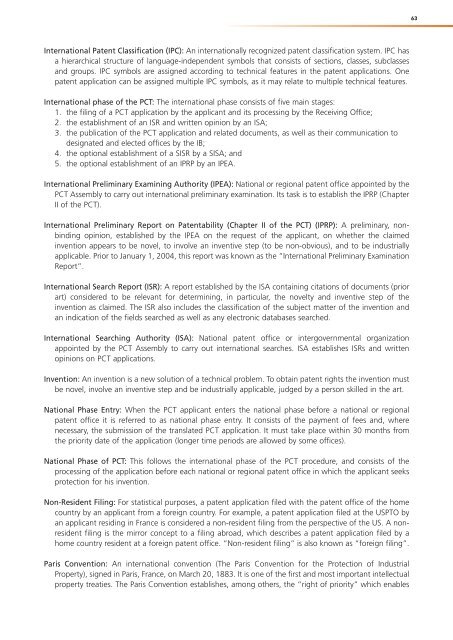PDF, PCT Yearly Review - WIPO
PDF, PCT Yearly Review - WIPO
PDF, PCT Yearly Review - WIPO
You also want an ePaper? Increase the reach of your titles
YUMPU automatically turns print PDFs into web optimized ePapers that Google loves.
63<br />
International Patent Classification (IPC): An internationally recognized patent classification system. IPC has<br />
a hierarchical structure of language-independent symbols that consists of sections, classes, subclasses<br />
and groups. IPC symbols are assigned according to technical features in the patent applications. One<br />
patent application can be assigned multiple IPC symbols, as it may relate to multiple technical features.<br />
International phase of the <strong>PCT</strong>: The international phase consists of five main stages:<br />
1. the filing of a <strong>PCT</strong> application by the applicant and its processing by the Receiving Office;<br />
2. the establishment of an ISR and written opinion by an ISA;<br />
3. the publication of the <strong>PCT</strong> application and related documents, as well as their communication to<br />
designated and elected offices by the IB;<br />
4. the optional establishment of a SISR by a SISA; and<br />
5. the optional establishment of an IPRP by an IPEA.<br />
International Preliminary Examining Authority (IPEA): National or regional patent office appointed by the<br />
<strong>PCT</strong> Assembly to carry out international preliminary examination. Its task is to establish the IPRP (Chapter<br />
II of the <strong>PCT</strong>).<br />
International Preliminary Report on Patentability (Chapter II of the <strong>PCT</strong>) (IPRP): A preliminary, nonbinding<br />
opinion, established by the IPEA on the request of the applicant, on whether the claimed<br />
invention appears to be novel, to involve an inventive step (to be non-obvious), and to be industrially<br />
applicable. Prior to January 1, 2004, this report was known as the “International Preliminary Examination<br />
Report”.<br />
International Search Report (ISR): A report established by the ISA containing citations of documents (prior<br />
art) considered to be relevant for determining, in particular, the novelty and inventive step of the<br />
invention as claimed. The ISR also includes the classification of the subject matter of the invention and<br />
an indication of the fields searched as well as any electronic databases searched.<br />
International Searching Authority (ISA): National patent office or intergovernmental organization<br />
appointed by the <strong>PCT</strong> Assembly to carry out international searches. ISA establishes ISRs and written<br />
opinions on <strong>PCT</strong> applications.<br />
Invention: An invention is a new solution of a technical problem. To obtain patent rights the invention must<br />
be novel, involve an inventive step and be industrially applicable, judged by a person skilled in the art.<br />
National Phase Entry: When the <strong>PCT</strong> applicant enters the national phase before a national or regional<br />
patent office it is referred to as national phase entry. It consists of the payment of fees and, where<br />
necessary, the submission of the translated <strong>PCT</strong> application. It must take place within 30 months from<br />
the priority date of the application (longer time periods are allowed by some offices).<br />
National Phase of <strong>PCT</strong>: This follows the international phase of the <strong>PCT</strong> procedure, and consists of the<br />
processing of the application before each national or regional patent office in which the applicant seeks<br />
protection for his invention.<br />
Non-Resident Filing: For statistical purposes, a patent application filed with the patent office of the home<br />
country by an applicant from a foreign country. For example, a patent application filed at the USPTO by<br />
an applicant residing in France is considered a non-resident filing from the perspective of the US. A nonresident<br />
filing is the mirror concept to a filing abroad, which describes a patent application filed by a<br />
home country resident at a foreign patent office. “Non-resident filing” is also known as “foreign filing”.<br />
Paris Convention: An international convention (The Paris Convention for the Protection of Industrial<br />
Property), signed in Paris, France, on March 20, 1883. It is one of the first and most important intellectual<br />
property treaties. The Paris Convention establishes, among others, the “right of priority” which enables

















